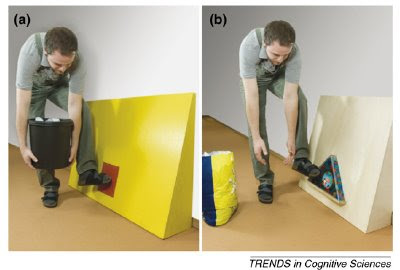In my last post I wrote about two experiments on imitation in young children and chimpanzees by Lyons et al. (2005) and Horner & Whiten (2005). Their results suggested that young children tend to copy both the ‘necessary’ and the ‘unnecessary’ parts of a demonstrator’s action who shows them how to get a reward out of a puzzle box, whereas chimps only copy the ones necessary to get the reward.
![]() One important question raised by these experiments was whether these results can only be applied to wild chimpanzees or whether they also hold for enculturated, human-raised chimps. This is an important question because it is possible that chimpanzees raised in these kinds of richly interactive contexts show more sensitivity to human intentionality.
One important question raised by these experiments was whether these results can only be applied to wild chimpanzees or whether they also hold for enculturated, human-raised chimps. This is an important question because it is possible that chimpanzees raised in these kinds of richly interactive contexts show more sensitivity to human intentionality.
Buttelman et al. (2007) tested just that. They used the “rational imitation” paradigm, which features two conditions
a) the subjects are shown an action in which the specific manner of the action is not purposive and intentional but results from the demonstrator being occupied with something else. For example, he may be carrying something so that he has to use his foot to turn on a light (often called the Hands Occupied Condition).
b) the subjects are shown an action in which the demonstrator chooses a specific manner of doing something on purpose. For example he may have his hands free but still choosto turn on the light with his foot (Hands Free Condition).
taken from Call & Tomasello 2008

